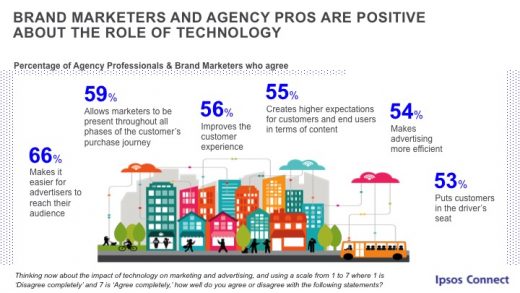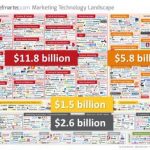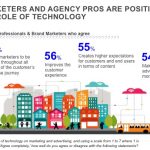It’s a mad, mad, MAdTech world
As the lines between media, advertising and technology blur, what does it mean for consumers and marketers? Columnist Peter Minnium discusses what has and hasn’t changed in our “brave new world.”

Technology is fundamentally reshaping the advertising and media landscapes; the fault lines between pure-play media and advertising are fast disappearing. We now live in a world in which media, advertising and technology — “MAdTech” — intersect to fundamentally alter how consumers “consume” content.
The intersection of tech, media and advertising — and what that means to consumers — reverberates throughout the marketing world; how marketers need to advertise and how media companies need to relate to consumers and advertisers are irrevocably changed and changing.
For many companies, this demands revolutionary change; changing fast to meet the demands of the new consumer is an existential need. More widespread is the evolutionary effect, as all companies must adapt to meet the higher expectations of the modern, empowered consumer with greater speed, flexibility and efficiency.
An Ipsos (my employer) proprietary study validates this notion: 85 percent of marketer and agency respondents agree that technology will play a key role in their next campaign. Notably, 94 percent of this same group agreed with the idea that we have entered a “brave new world” where media, advertising and technology are coming together.

Those who have responsibility for creating advertising, content and other marketing programs, as well as those who make the final decision about advertising, media and digital media marketing, are more likely to agree strongly with the concept.
MAdTech changes everything
The implications for advertising and media are widespread, and, for the most part, agency influencers and marketers are positive about the increasingly influential role of technology in their businesses, with two-thirds saying they thought it made it easier to reach their audience. Agency respondents were significantly more likely to point this out.

More than half said it helps marketers to be present throughout all phases of the customer’s purchase journey. Those who make the final decision about advertising, media and digital media marketing are most likely to feel this way (70 percent).
Content creators and final decision-makers were significantly more likely to say technology has created higher expectations for customers and end users, as well as that it “puts customers in the driver’s seat.” Agency respondents and those involved in advertising were more likely to say that technology makes advertising more effective.
MAdTech changes nothing
For all the changes in how we can reach and communicate with audiences of consumers, an important fundamental has not changed: the human brain.
Dramatic changes will continue in ad products (e.g., from 30-second TVCs to in-feed native ads) and content delivery platforms (e.g., TVs to phones) but not in the capacity of the human brain to pay attention, process information and make decisions.
For content creators and platforms, the rules of engaging people are the same today as when our early ancestors gathered around the fire. It all starts with a story.
Humans have a built-in ability to find patterns in the distinct happenings of life and weave them together to find meaning. That’s how we come to know how the world works.
Cave paintings from long ago show that we’ve always made sense of the world this way. Storytelling remains the most important tool to engage audiences by meeting the fundamental need for emotional fulfillment and connection.
While our stories have not changed, our capacity to tell them has evolved from cave paintings to campfires to social media posts and beyond. And they’ve moved from linear storytelling, i.e., with a beginning, middle and end in structured formats, to systemic story-building — think a simultaneous expression of story elements that come together to form a single impression.
For advertisers, the perennial challenges remain in a MAdTech world. All advertising, digital or not, must traverse a difficult course to be successful — in being linked to the brand, conveying a message, being persuasive and driving favorability, loyalty and action.
After creating an opportunity to see, an ad needs to get the viewer’s attention. That requires the information to pass from the right-brain-controlled sustained attention to the left brain’s focused attention, which then stimulates cognitive processing sufficient to establish a memory.
Have advertisers been too smitten with shiny new digital objects and neglected these basics? Are they “in too deep” when it comes to digital? Have they simply jumped on the bandwagon?
Six in 10 agency respondents expressed concern that they have “drunk the digital Kool-Aid” and overly rely on digital. This is significantly higher among agency respondents compared with client-side marketers and is also higher among those involved in media buying compared with those involved in other areas.

Similarly, agency respondents were significantly more likely to express concern about “pushing the envelope too far.”
Among marketers, there is a correlation between those who indicate that “we’re too risk-averse” and concern that we’re “pushing the envelope” too far — suggesting confusion regarding the right level for their digital initiatives.
Making sense of MAdTech
Making sense of MAdTech starts with data and insights — only one of which is readily available.
Survey respondents overwhelmingly reported that they are drowning in data but starving for actionable insights. Agency respondents and media buyers are most likely to feel that they have an overwhelming amount of data at their fingertips (about 75 percent for each), while nearly two-thirds of all respondents reported that finding actionable insights in the data was a pain point.


Technology has brought with it countless new ways to quantify, measure and track — but apparently too few metrics that matter to advertisers. Tracking and measuring brand and advertising effectiveness were cited as the top success factors in digital marketing and advertising.

Yet these factors were likewise noted as key areas where organizations need help.

The MAdTech mashup
The walls between advertising, media and technology have crumbled. Gone are the days when advertising and media and tech experts collaborated on behalf of brands from their separate silos.
Today’s audience of consumers has become expert at using technology to curate and craft their own media experience on a minute-to-minute level. They expect brands and content creators and platforms to add personal value to their handmade content streams — wherever and whenever they want to engage.
Some opinions expressed in this article may be those of a guest author and not necessarily Marketing Land. Staff authors are listed here.
(Some images used under license from Shutterstock.com.)
Marketing Land – Internet Marketing News, Strategies & Tips
(31)















